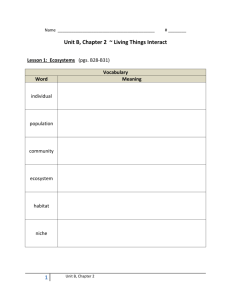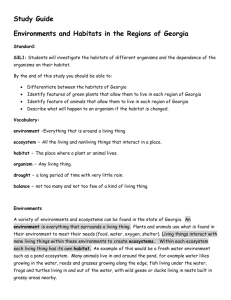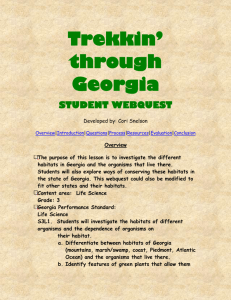Differentiation Ideas S3L1
advertisement
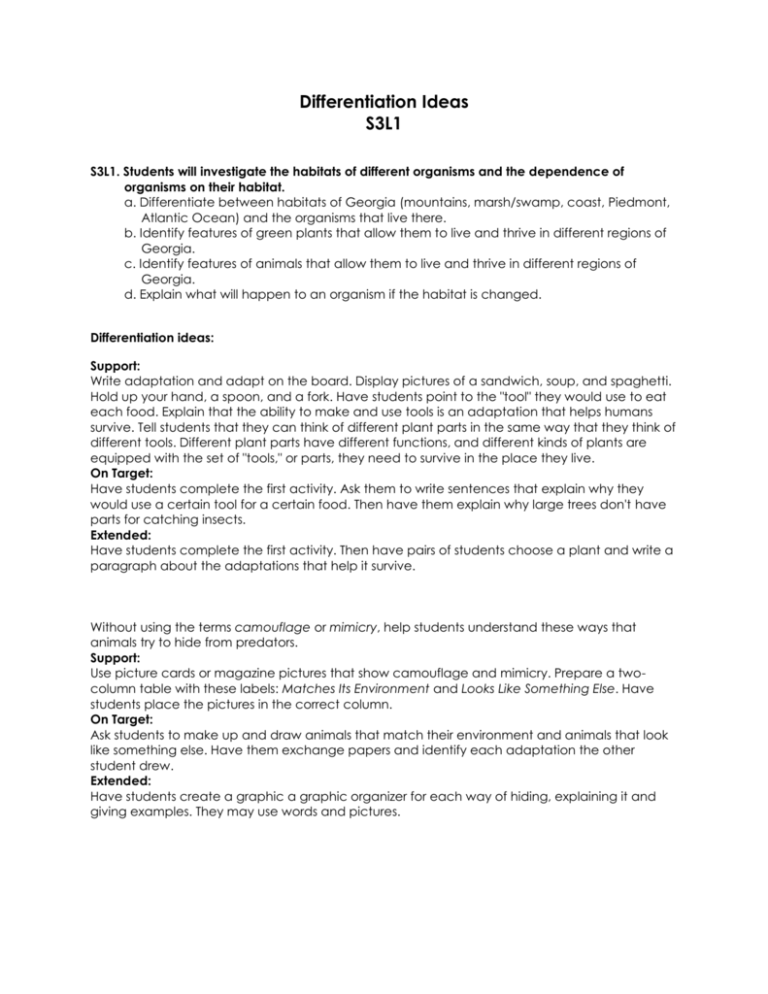
Differentiation Ideas S3L1 S3L1. Students will investigate the habitats of different organisms and the dependence of organisms on their habitat. a. Differentiate between habitats of Georgia (mountains, marsh/swamp, coast, Piedmont, Atlantic Ocean) and the organisms that live there. b. Identify features of green plants that allow them to live and thrive in different regions of Georgia. c. Identify features of animals that allow them to live and thrive in different regions of Georgia. d. Explain what will happen to an organism if the habitat is changed. Differentiation ideas: Support: Write adaptation and adapt on the board. Display pictures of a sandwich, soup, and spaghetti. Hold up your hand, a spoon, and a fork. Have students point to the "tool" they would use to eat each food. Explain that the ability to make and use tools is an adaptation that helps humans survive. Tell students that they can think of different plant parts in the same way that they think of different tools. Different plant parts have different functions, and different kinds of plants are equipped with the set of "tools," or parts, they need to survive in the place they live. On Target: Have students complete the first activity. Ask them to write sentences that explain why they would use a certain tool for a certain food. Then have them explain why large trees don't have parts for catching insects. Extended: Have students complete the first activity. Then have pairs of students choose a plant and write a paragraph about the adaptations that help it survive. Without using the terms camouflage or mimicry, help students understand these ways that animals try to hide from predators. Support: Use picture cards or magazine pictures that show camouflage and mimicry. Prepare a twocolumn table with these labels: Matches Its Environment and Looks Like Something Else. Have students place the pictures in the correct column. On Target: Ask students to make up and draw animals that match their environment and animals that look like something else. Have them exchange papers and identify each adaptation the other student drew. Extended: Have students create a graphic a graphic organizer for each way of hiding, explaining it and giving examples. They may use words and pictures. Help students learn the features of Georgia’s regions and habitats and the organisms that live there. Support: Have students illustrate each of the Georgia habitats. Students should label each habitat. On Target: Have students make booklets, labeling each page with the name of a region. They should draw pictures of plants and animals that live in these regions and write a sentence about each. Extended: Make ecosystem flash cards. Include the names of plants and animals found in each ecosystem. Invite students to make up a game using the word cards. Have students share information about how ecosystems change. Support: Have students choose an ecosystem they learned about and draw a picture of it. Then tell them that a fire has taken place. Students should draw a picture to show how the ecosystem has changed. On Target: Provide pictures of ecosystems. Challenge students to identify changes that could happen in the ecosystem. Ask them to record their ideas about how to protect the ecosystem. Extended: Have students form teams and make lists of ways nature and people can cause changes in ecosystems. Have them circle changes that might be prevented. Differentiated Informal Assessment Ideas: Support: Have students select an environment and draw or copy what it looks like, including plants and animals. Have students write or copy words that identify things in their drawings. Have them tell about their drawings. On Target: Prepare a word-web graphic organizer for students to copy. In the center, have students write the name of an ecosystem, such as swamp, forest, or ocean. Once students have chosen an ecosystem, have them brainstorm the names of plants and animals that live in it. Extended: Have students design their own graphic organizers to show the organisms that live and interact in a particular ecosystem. Ask students to identify plants and animals that live near your home. Make a list. Have students choose one of the plants or animals. They should make a word web describing its habitat. Then write a description of the plant or animal’s habitat, including some of the terms in your word web. Support: Give students a picture of a Georgia plant or animal in its habitat to use during the activity. On Target: Choose on plant or animal as a class and make a word web together. Then have students make their own webs. Extended: Have students complete one word web for a plant and one for an animal. Ask them to color bubbles that are similar on both webs. Have students write a travel brochure for one of Georgia’s regions. Students should describe things visitors will enjoy about that region. They should include a description of the plants and animals that can be found there. Support: Students can create oral recordings of their descriptions instead of writing them. On Target: Remind students that good descriptive writing requires the selection and communication of specific details. Emphasize the importance of observing carefully and describing with accuracy. Extended: Ask students to write a nonrhyming poem that describes the organism they have chosen and its habitat. Support: Have students draw pictures of several different plants found in Georgia. Have them label and write captions for their pictures. The label should indicate the kind of plant and its adaptation. The caption should be one sentence that describes how the plant uses its adaptation. On Target: Ask students to list ways plants use their adaptations to survive in swamps and dry habitats. Have them compare their lists. Extended: Have students use maps to locate a habitat in Georgia and have them use library or Internet sources to research information about the kinds of plants that grow there.


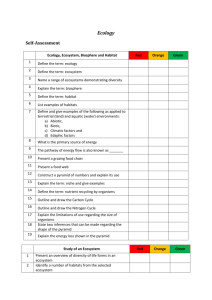

![HabitatsOrganismsnewsletter[1]](http://s3.studylib.net/store/data/007214856_1-1740411bb520253279cc4e06031ca006-300x300.png)



